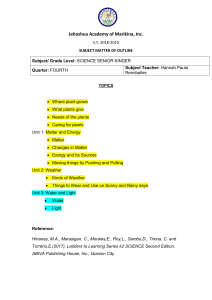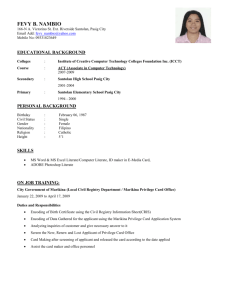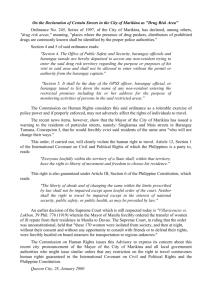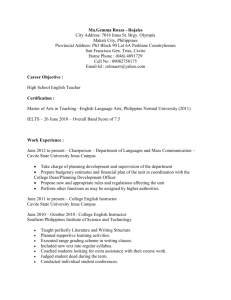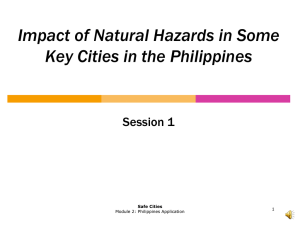Urban River Rehabilitation Case Study: Marikina City, Philippines
advertisement
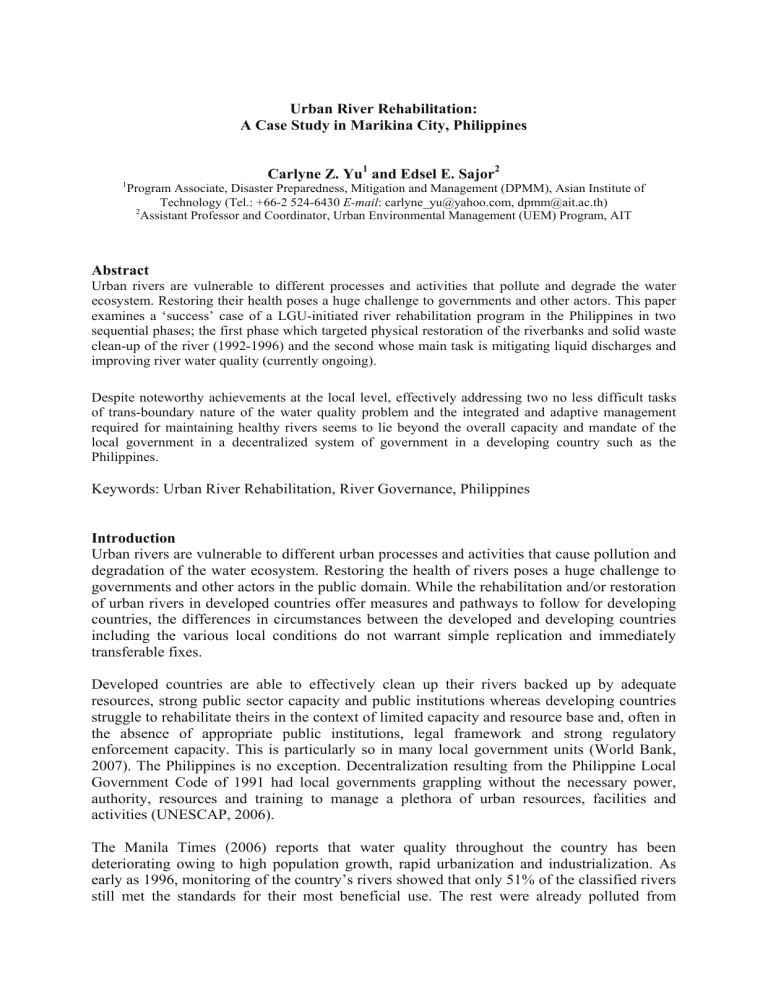
Urban River Rehabilitation: A Case Study in Marikina City, Philippines Carlyne Z. Yu1 and Edsel E. Sajor2 1 Program Associate, Disaster Preparedness, Mitigation and Management (DPMM), Asian Institute of Technology (Tel.: +66-2 524-6430 E-mail: carlyne_yu@yahoo.com, dpmm@ait.ac.th) 2 Assistant Professor and Coordinator, Urban Environmental Management (UEM) Program, AIT Abstract Urban rivers are vulnerable to different processes and activities that pollute and degrade the water ecosystem. Restoring their health poses a huge challenge to governments and other actors. This paper examines a ‘success’ case of a LGU-initiated river rehabilitation program in the Philippines in two sequential phases; the first phase which targeted physical restoration of the riverbanks and solid waste clean-up of the river (1992-1996) and the second whose main task is mitigating liquid discharges and improving river water quality (currently ongoing). Despite noteworthy achievements at the local level, effectively addressing two no less difficult tasks of trans-boundary nature of the water quality problem and the integrated and adaptive management required for maintaining healthy rivers seems to lie beyond the overall capacity and mandate of the local government in a decentralized system of government in a developing country such as the Philippines. Keywords: Urban River Rehabilitation, River Governance, Philippines Introduction Urban rivers are vulnerable to different urban processes and activities that cause pollution and degradation of the water ecosystem. Restoring the health of rivers poses a huge challenge to governments and other actors in the public domain. While the rehabilitation and/or restoration of urban rivers in developed countries offer measures and pathways to follow for developing countries, the differences in circumstances between the developed and developing countries including the various local conditions do not warrant simple replication and immediately transferable fixes. Developed countries are able to effectively clean up their rivers backed up by adequate resources, strong public sector capacity and public institutions whereas developing countries struggle to rehabilitate theirs in the context of limited capacity and resource base and, often in the absence of appropriate public institutions, legal framework and strong regulatory enforcement capacity. This is particularly so in many local government units (World Bank, 2007). The Philippines is no exception. Decentralization resulting from the Philippine Local Government Code of 1991 had local governments grappling without the necessary power, authority, resources and training to manage a plethora of urban resources, facilities and activities (UNESCAP, 2006). The Manila Times (2006) reports that water quality throughout the country has been deteriorating owing to high population growth, rapid urbanization and industrialization. As early as 1996, monitoring of the country’s rivers showed that only 51% of the classified rivers still met the standards for their most beneficial use. The rest were already polluted from domestic, industrial and agricultural sources (EMB, 2007). The major source of water pollution is domestic wastewater, accounting for 48% of the total pollution sources. While domestic wastewater is pinpointed to be the principal cause of organic pollution of water bodies, only 3% of investments in water supply and sanitation were going to sanitation and sewage treatment (EMB, 2007). More than 90% of sewage is not treated and disposed of in an environmentally sound manner. Residents rely on private solutions such as open drains and poorly constructed septic tanks to dispose of human and liquid wastes thereby polluting and degrading the surrounding urban areas and water bodies (Manila Times, 2006). It is no surprise that the Department of Environment and Natural Resources-Environmental Management Bureau (DENR-EMB) lists the rehabilitation of rivers as one of the key challenges faced by the country. The bureau initiated a Sagip Ilog Program (Save Rivers Program) and selected 19 priority rivers, including Marikina River for monitoring. The River Rehabilitation Program Marikina River is the town’s main waterway and is a major tributary to Pasig River. It stretches from Rodriguez, Rizal to Pasig City. During its heyday, it was the picnic ground of the town folks who held fiestas in the vicinity of the river. But some four decades ago, the river was all filth and stench due to uncontrolled encroachment and indiscriminate disposal of both domestic and industrial wastes causing the deterioration of its water quality (Fernando, 1994). Borje et.al. (2004c) writes that the river merely served as a dumping area and no one ever dared to go near it. The ‘Save the Marikina River’ Program was then conceptualized and implemented to revive by rehabilitation the Marikina River and its environs and, develop it as the city’s biggest recreational and sports area. The program was implemented during the incumbency of former 1 Mayor Bayani Fernando (1992-2001) as stipulated in his Program of Government. The former Mayor even promoted a program’s principle; The people have to touch and smell the water. It is hoped that this experience and exposure will galvanize them to muster enough political pressure for the government and the rest to act and conserve the river (Fernando 1994, p. 1). The Mayor intended to showcase river rehabilitation not simply as one of those government programs on environmental preservation, but to communicate to his constituents that the local government is seriously working on such a program and that it is its business to entice them to clean up, follow what the laws say about sanitation, encroachment, among many others (Borje et.al., 2004c). Marikina City started river rehabilitation work since the early part of 1993, without any completion date. After more than a decade of development, the landscape was transformed from being much polluted, flood-prone and adorned with informal settlements to one with free-flowing water, less flooded areas and with river park amenities such as an 11-km jogging/biking lane, skating rink (reportedly the biggest in the country), tree planting pockets, picnic and play grounds, sports amenities like baseball field and basketball court, a Youth Camp, a Chinese Pagoda, a Roman Garden, a gazebo, a riverboat, floating stages, 1 Now Chairman of Metro Manila Development Authority (MMDA), Bayani Fernando served three consecutive terms (equivalent to nine years), as Mayor of Marikina amphitheater and a Senior Citizens’ Lifestyle Center (Borje et.al., 2004c). The task of rehabilitating was by no means simple. It involved relocating riverbank communities, addressing flooding problems and conducting dredging operations before the river had to be developed into a recreational park. These interrelated issues were dealt with strategically from the top while specific projects and activities were assigned to particular Departments and/or Offices within the city. The then Mayor oversaw the general plan and had the direct and final word on many aspects of it, a case illustrative of a top-down management style. The events leading to the creation of the Marikina River Park generated mixed responses from the relocated communities, national government agencies and international organizations. Some of the informal settlers in the river were receptive while others were indignant. But more than a decade after the relocation, the affected communities are generally more satisfied with their present conditions having more secure lands and houses with improved access to infrastructure, community facilities and services. These present circumstances seem to ‘justify’ the non-consultative and compelling nature of the demolitions in the past. The City’s rehabilitation program received various citations and awards as well as further support for related supplementary projects. But even if the river had been cleaned of its squatter settlements, which were believed to be major sources of pollution in the past, water quality remains to be a big problem and domestic sources account for much of the pollution loading according to an article in Manila Water (2007) so then the city turns toward abating water pollution and improving the river’s water quality via the introduction of Wastewater Treatment Plants (WTP). The latter project not only advocates for the construction of WTPs all over the city, but also calls for the appropriate construction of septic tanks in order to prevent groundwater contamination. The Clean Water Act of 2004 provided, in part, the impetus for Marikina and Manila Water to coordinate efforts at treating wastewater, the latter being the agency mandated to provide water and wastewater services in the city. Further partnerships were also entered into by the city giving birth to the ‘Clean Water, Clean River’ project with USAID’s ECO-Asia as the primary funding institution. These collaborations thereby created a different management structure for the city’s water quality improvement project, now including the private sector and the donor agency, both of which have their own upheld organizational norms and principles. While Marikina may not be obligated to Manila Water, it is compelled to respect and follow the working principles of USAID, having signed a memorandum with it as the donor. This meant a compromise from the top-down, local government-centered planning and implementation of the first phase to a more collaborative approach on planning with the participation of stakeholders as espoused by the donor agency. Interestingly, the policy instruments used by the local government have also been greatly influenced by its donor, with particular focus on information and education campaign or ‘social marketing’ in the second phase. These have not only informed people but have also involved representatives in the planning process at their respective level and area. A regulation on septage management is underway also but there is very little mention of incentives for treating wastewater. On the contrary, individuals who avail of the wastewater service may be asked to pay for the service thereby complicating the problem for a service that is new and an (environmental) aim which has been sought after by Marikina City alone. Marikina River Rehabilitation vis-à-vis Comprehensive River Management Marikina was successful in removing and relocating previous riverbank communities into incity resettlement sites. It also provided those resettlement sites improved access to basic services, infrastructure and communal facilities such as basketball courts, playgrounds and community halls (MSO, 2007). The local government also boasts of an effective solid waste management system, with a garbage collection efficiency rate of 98% (WMO, 2007). The system had been established with the aim of preventing direct or indirect dumping of solid wastes on waterways. Another component which the local government was also able to address is the problem on flooding. The LGU improved the river being the city’s principal drainage system through massive dredging operations and bank improvements. Flooding was reduced significantly from that which used to cover an area of about 27.52% (6.4 km2) of the entire city in 1992 to 19.04% or 4.4km2 in 2004 (Borje et.al., 2004a). Floodwaters also recede faster due to the decreased build up of sludge at the riverbed. Finally, the city developed the whole stretch of the river into a recreational park. Trees were planted on the banks to prevent erosion and communities field their own patrols to stop those who dump garbage (Gallego, 2004). Mini plazas were created and these provided venues for programs and games thereby bringing back a sense of community seldom seen in the harried world (Ramos, 1994). In fact, the World Bank and National Disaster Coordinating Council (2004) reports that the developments in Marikina River indirectly benefited the LGU in terms of higher property tax revenues resulting from a 10-fold rise in property values. Despite these improvements, the river ecosystem particularly in terms of its water quality and the species that thrive in it are two major challenges which the local government is struggling with. Water quality remains to be worst than class D according to the Laguna Lake 2 Development Authority (2005) and the river is suffering from Pterygoplichthys pardalis infestation. Although these do not pose any direct threat to humans and other fishes, they multiply rapidly, eat voraciously, compete with other fish for food and further eat the eggs of other fish species thereby causing the latter’s depletion. They also bore holes on the soft, muddy banks to create breeding nests, damaging the river’s plant life and causing the river’s sides to erode (ADB, 2006). Furthermore, while the rehabilitation of Marikina River has been well-recognized by local, national as well as international organizations, the efforts remain confined and concentrated to Marikina alone. There is no steering committee, no legal and institutional framework in managing the entire river basin, over and above local administrative boundaries. As well, the fact that the river and its rehabilitation brought fame not only to the city but also to its leader may have affected other politicians who would like to build their own legacies and therefore choose to have different priorities and programs. In any case, the program was exclusively done by the city with very limited interaction and collaboration with those outside of the city’s sphere of influence. Although the exclusivity in the first phase offered ease of control for the LGU to direct its resources in solving its riverbank squatting issues, flooding as well as solid waste 2 The rise of Pterygoplichthys pardalis, more commonly known as janitor fish posed greater problems not just in Marikina but also in neighboring Pasig River and Laguna Lake. This affected fishers who now report reduction of fish catch and loss of livelihoods and incomes. The DENR and other agencies are still experimenting ways to curb Pterygoplichthys pardalis infestation in these water bodies. management problems, the second phase needed to address the trans-boundary nature of the water and therefore its vulnerability to pollution from different sources. Even with the passing and implementation of the Clean Water Act four years ago (2004), there is still no institutional framework or river basin plan established mainly for the management of Marikina River. Marikina City, per se, lacks the financial capability, technical expertise and appropriate technology as well as local knowledge and awareness on sanitation and the environment (ECO-Asia, 2006). The lack of funds compels the city to seek and maximize external sources of funding for its programs. It had since then partnered with Manila Water and USAID’s ECO-Asia, the former for the provision of WTPs in strategic areas in the city while the latter for capacity-building, social marketing and a pilot project on decentralized WTP. The city resorts to incremental and decentralized approaches to wastewater treatment instead of the more expensive centralized WTPs. These approaches, in turn, require significant levels of community mobilization and stakeholder cooperation in the operation and maintenance of the systems. Conclusion River rehabilitation is a complex environmental management program so that its planning and management need to adapt to the change in circumstances. This is the challenge in the second phase, with river water quality improvement heavily dependent on community support and external donor provision due to the lack of public funds. The question on why the rehabilitation of Singapore River only took ten years to conclude its success can partly be answered by the availability of resources and the enhanced capability of the nation-state to address its problems (UNEP, 1997). On the other hand, developing country cities such as Marikina lack the necessary capacity in terms of expertise and funding required to fully undertake infrastructure projects so that it must rely on other means of ensuring sustainability, of balancing economic development with resource conservation and environmental resources management (UNESCAP, 2006). While developed countries have already looked into adaptive, integrative and river basin management frameworks that cross local administrative jurisdictions, urban rivers in developing countries have yet to establish institutional frameworks that effectively operate over and beyond the political boundaries of local governments. Marikina illustrates a local initiative that is neither shared by any other city nor municipality in the entire River Basin despite the fame of the river’s transformation. Although the nature of the water quality problem in the river is trans-boundary, there was not and there is no river basin commission created to govern the river so that the efforts of Marikina are weighed down by continued pollution coming from elsewhere. Public participation in water resources management processes has also been limited and only very recently initiated by the local government, which according to Lorenzo (2007) is still bureaucratic. The case proves the claim of the World Bank (2007) on the limited capacity of LGUs in governing environmental and natural resources. As posited by UNESCAP (2006), local governments need to be trained in managing urban resources, facilities and activities they are mandated and authorized to govern. Aside from this, it must be noted that while there had been widespread decentralization since the 1980’s, nature does not follow political and administrative boundaries set by governments. As such, local initiatives will remain insufficient no matter how participatory and inclusive the planning had evolved to include communities and various stakeholders. Unless and until the entire resource is managed holistically, the problem on pollution and mismanagement remains. The Marikina River Rehabilitation Program indeed demonstrated how small initiatives can generate noteworthy improvements and enthusiasm from various groups. At the same time, it also highlighted the limitations of these local initiatives in improving the overall condition of a publicly shared resource. Environmental management, water resources and river management, in particular, need to be integrative, adaptive and, more importantly, to cross political boundaries. These management modalities tend to go against the principles of decentralization with its (fragmented) management of resources based on territorial jurisdictions. References ADB (Asian Development Bank, 2006) Country Water Action: Philippines. Eradicating the Marikina River’s Fish Menace http://www.adb.org/water/actions/PHI/marikina-river.asp [Accessed: April 17, 2008] Borje, J. and the rest of the Marikina Team (2004a) Marikina City Flood Mitigation Countermeasure Program. Sound Practice No.7, 3cd Sound Practice Series. Metropolitan Manila, Philippines [Accessed: February 20, 2008] Borje, J. and the rest of the Marikina Team (2004b) Marikina City Squatter-Free Program. Sound Practice No.7, 3cd Sound Practice Series. Metropolitan Manila, Philippines [Accessed: February 20, 2008] Borje, J. and the rest of the Marikina Team (2004c). Save the Marikina River. Sound Practice No.6, 3cd Sound Practice Series. Metropolitan Manila, Philippines [Accessed: July 20, 2007] ECO-Asia (2006). Water and Sanitation. Sanitation and Wastewater Services in Marikina City, Philippines http://watsan.eco-asia.org/sus_san/marikina/ [Accessed: March 8, 2008] EMB-Environmental Management Bureau-DENR (2007), The Water Quality Management Section, Visayas Avenue, Quezon City, http://www.emb.gov.ph [Accessed: September 2, 2007] Fernando, B (1994) Save Marikina River (Marikina River Park Project): A Re-appraisal Gallego, A. (2004). Standard. Marikina River’s new look lauded. July 18, 2004 Lejano, R.P. (2006), The Design of Environmental Regimes: Social Construction, Contextuality, and Improvisation, International Environmental Agreements, 6:187-207 LLDA (2005) Laguna Lake Development Authority. [Accessed: April 18, 2008] http://www.llda.gov.ph/SD_Mondriaan/MonthlyReport_files/2005/December_Home.htm Manila Times (2006) Special Report: Sewage and Sanitation, ‘Ayala’s MWCI builds good sewerage systems’, Tuesday, September 12, 2006 [Accessed: August 31, 2007] Manila Water (2007) Customer Service News (August 28, 2007) BF calls for unified action to clean up Marikina River http://www.manilawater.com/news/bf-calls-for-unified-action-toclean-up-marikina-river [Accessed: March 8, 2008] MSO (2007). Marikina Settlements Office. Basic Community Profile. Ramos, C. (1994). Manila Bulletin. Marikina river campaign lauded. July 17, 1994 UNEP (1997) United Nations Environment Programme. Freshwater Issues. in Vandeweerd, V., M. Cheatle, B. Henricksen, M. Schomaker, M. Seki and K. Zahedi. Global Environment Outlook (GEO) – UNEP Global State of Environment Report 1997 http://www.unep.or.jp/ietc/Issues/Freshwater.asp [Accessed: March 23, 2008] UNESCAP (2006), Urban Governance: Global Vision and Local Needs – Assessment, Analysis and Action by City Governments WB-World Bank. Philippines Environment. [Accessed: September 10, 2007] http://web.worldbank.org/WBSITE/EXTERNAL/COUNTRIES/EASTASIAPACIFICEXT/E XTEAPREGTOPENVIRONMENT/0,,contentMDK:20266328~menuPK:3558267~pagePK:3 4004173~piPK:34003707~theSitePK:502886,00.html WB and NDCC (2004). World Bank and National Disaster Coordinating Council, Philippines. Natural Disaster Risk Management in the Philippines: Enhancing Poverty Alleviation Through Disaster Reduction. Regional VPU WMO (Waste Management Office) 2007. Situationer Marikina: All About Water Marikina City. Powerpoint Presentation.
